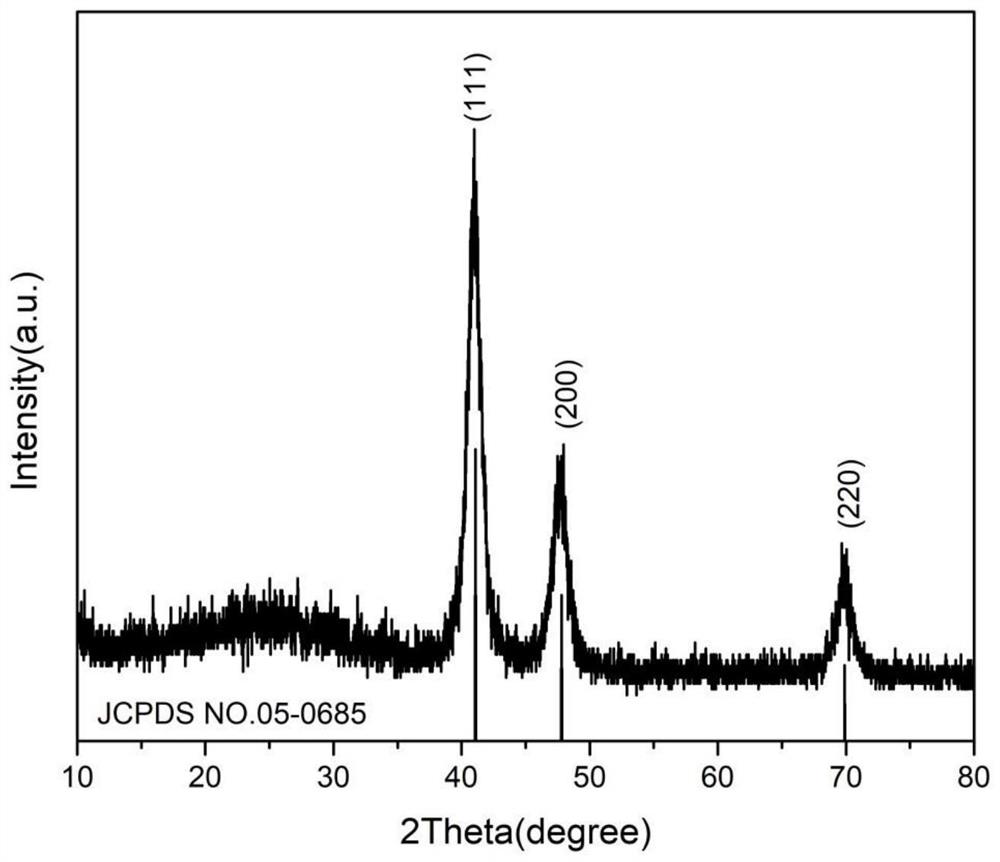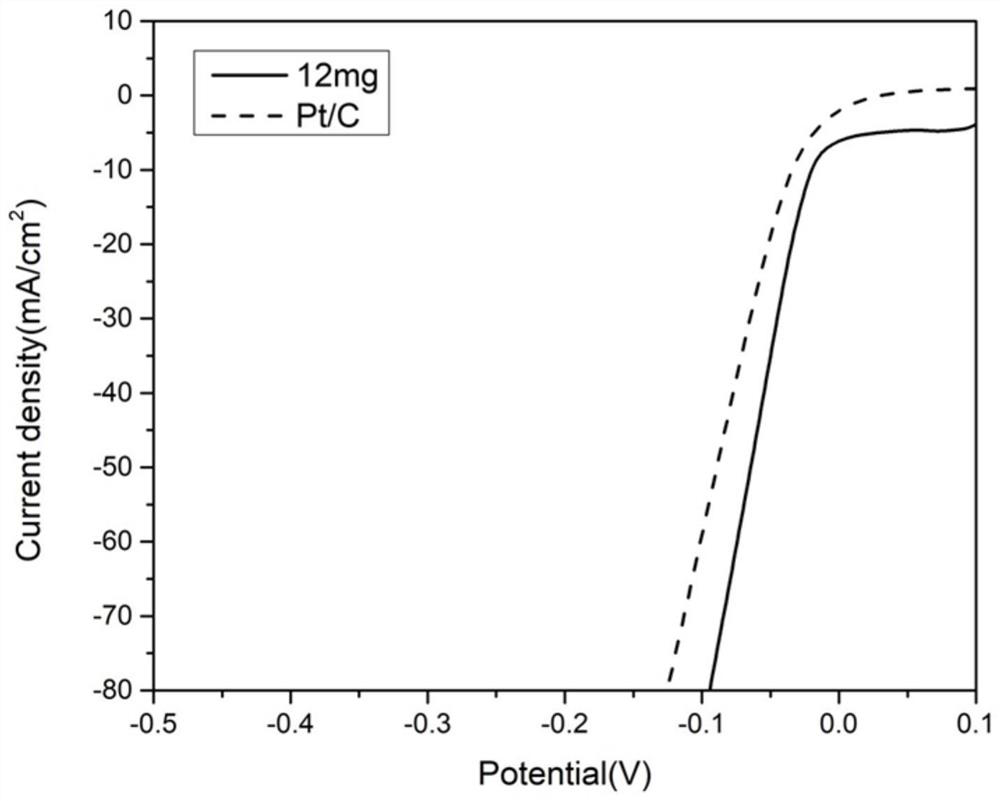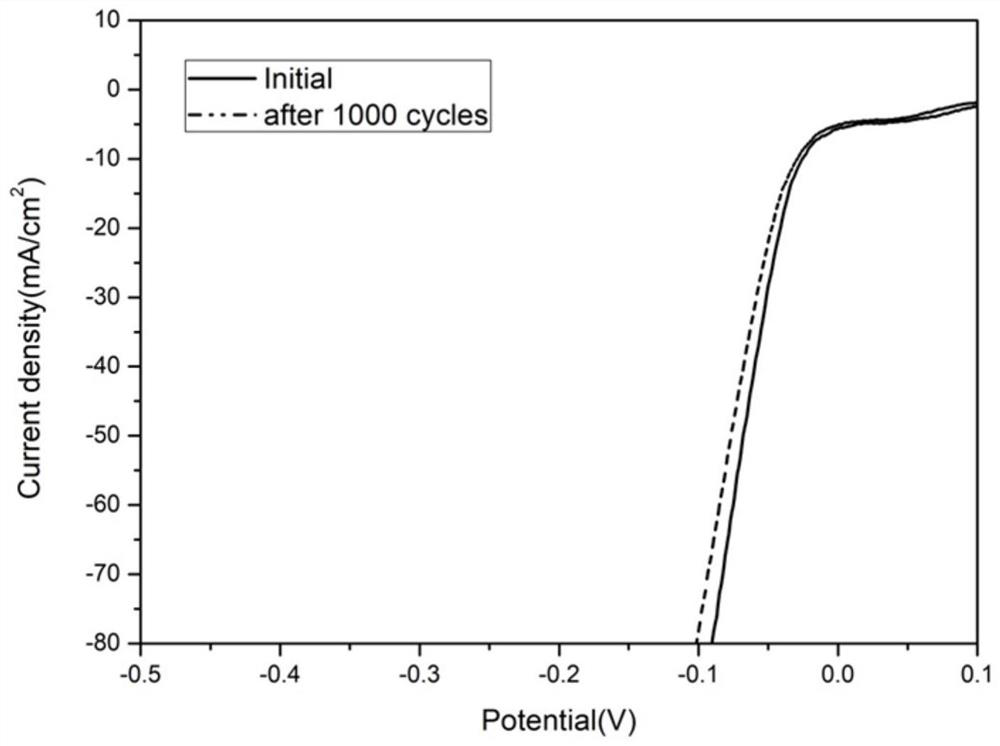Preparation method and application of rhodium-based electro-catalytic material
An electrocatalytic material, rhodium-based technology, applied in the field of electrocatalytic hydrogen evolution, can solve the problems of poor catalytic performance, easy agglomeration, weakened electrocatalytic effect of rhodium-based hydrogen evolution electrocatalytic material, etc. The effect of catalytic hydrogen evolution effect
- Summary
- Abstract
- Description
- Claims
- Application Information
AI Technical Summary
Problems solved by technology
Method used
Image
Examples
Embodiment 1
[0032] (1) In a 250ml beaker A, put a stirring bar, then add 0.2g melamine, and 12mg rhodium trichloride, after adding 80ml distilled water, put the beaker A on a magnetic stirrer for 1 hour. In a 100ml beaker B, add 0.2g cyanuric acid, then add 80ml distilled water, and ultrasonically dissolve it for 30 minutes.
[0033] (2) Pour the dissolved cyanuric acid solution, namely beaker B, into the melamine solution dissolved with rhodium trichloride, namely beaker A, and continue stirring for 1 hour at room temperature to obtain a mixed solution.
[0034] (3) The mixed solution was then placed in a 200ml reaction kettle, kept at 180° C. for 6 hours, and cooled to room temperature to obtain a reacted mixed solution.
[0035] (4) Then, the mixed solution in (3) is suction-filtered and then dried, and the drying condition is 80° C. for 12 hours to obtain a self-assembly precursor.
[0036] (5) Transfer the self-assembled precursor to a quartz boat, cover it and place it in a tube fu...
Embodiment 2
[0038] (1) In a 250ml beaker A, put a stirring bar, then add 0.2g melamine, and 2mg rhodium trichloride, after adding 80ml distilled water, put the beaker A on a magnetic stirrer for 1 hour. In a 100ml beaker B, add 0.2g cyanuric acid, then add 80ml distilled water, and ultrasonically dissolve it for 30 minutes.
[0039] (2) Pour the dissolved cyanuric acid solution, namely beaker B, into the melamine solution dissolved with rhodium trichloride, namely beaker A, and continue stirring for 1 hour at room temperature to obtain a mixed solution.
[0040] (3) The mixed solution was then placed in a 200ml reaction kettle, kept at 180° C. for 6 hours, and cooled to room temperature to obtain a reacted mixed solution.
[0041] (4) Then, the mixed solution in (3) is suction-filtered and then dried, and the drying condition is 80° C. for 12 hours to obtain a self-assembly precursor.
[0042] (5) Transfer the self-assembled precursor to a quartz boat, cover it and place it in a tube fur...
Embodiment 3
[0044] (1) In a 250ml beaker A, put a stirring bar, then add 0.2g melamine and 6mg rhodium trichloride, after adding 80ml distilled water, put the beaker A on a magnetic stirrer for 1 hour. In a 100ml beaker B, add 0.2g cyanuric acid, then add 80ml distilled water, and ultrasonically dissolve it for 30 minutes.
[0045](2) Pour the dissolved cyanuric acid solution, namely beaker B, into the melamine solution dissolved with rhodium trichloride, namely beaker A, and continue stirring for 1 hour at room temperature to obtain a mixed solution.
[0046] (3) The mixed solution was then placed in a 200ml reaction kettle, kept at 180° C. for 6 hours, and cooled to room temperature to obtain a reacted mixed solution.
[0047] (4) Then, the mixed solution in (3) is suction-filtered and then dried, and the drying condition is 80° C. for 12 hours to obtain a self-assembly precursor.
[0048] (5) Transfer the self-assembled precursor to a quartz boat, cover it and place it in a tube furna...
PUM
 Login to View More
Login to View More Abstract
Description
Claims
Application Information
 Login to View More
Login to View More - R&D
- Intellectual Property
- Life Sciences
- Materials
- Tech Scout
- Unparalleled Data Quality
- Higher Quality Content
- 60% Fewer Hallucinations
Browse by: Latest US Patents, China's latest patents, Technical Efficacy Thesaurus, Application Domain, Technology Topic, Popular Technical Reports.
© 2025 PatSnap. All rights reserved.Legal|Privacy policy|Modern Slavery Act Transparency Statement|Sitemap|About US| Contact US: help@patsnap.com



